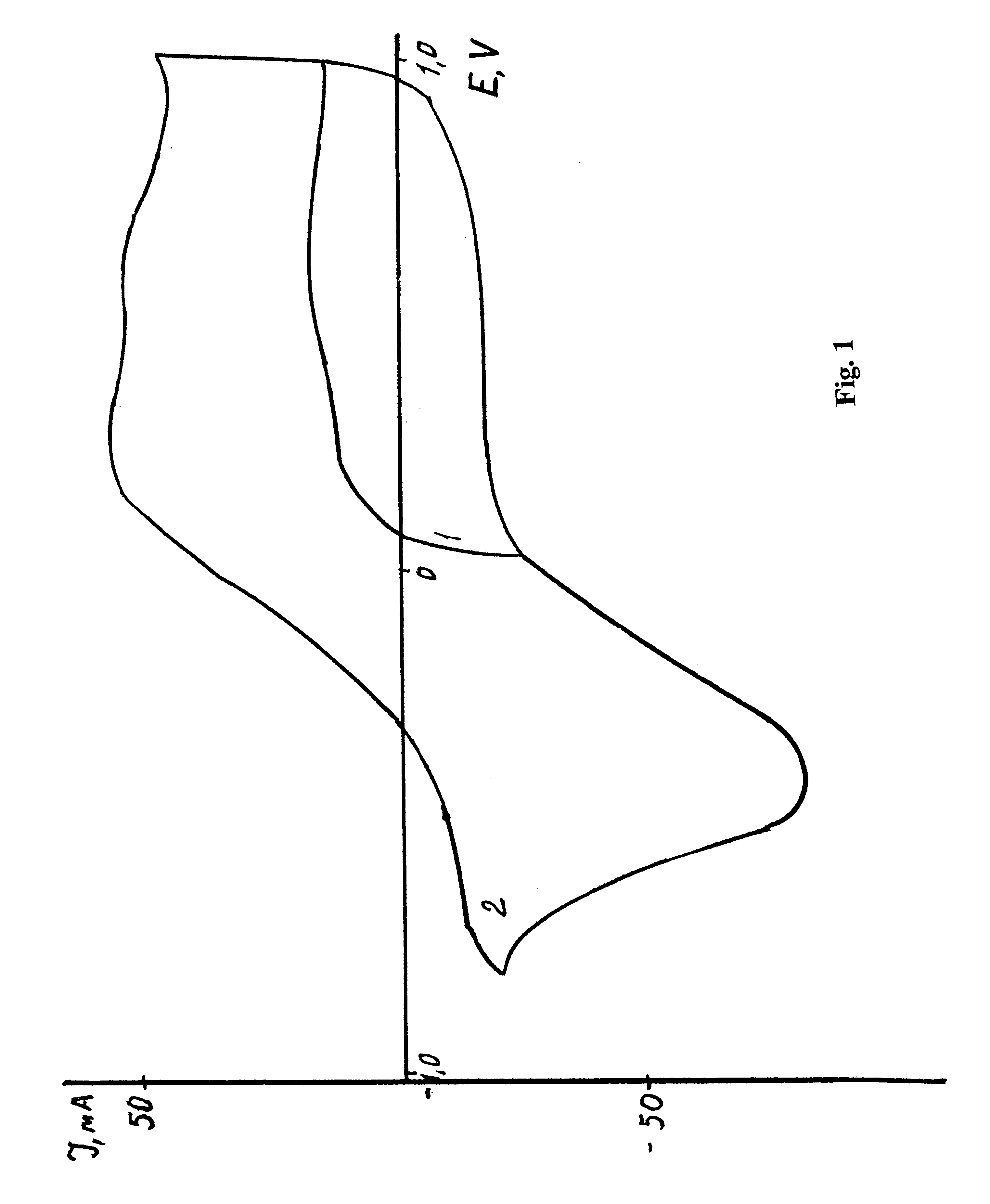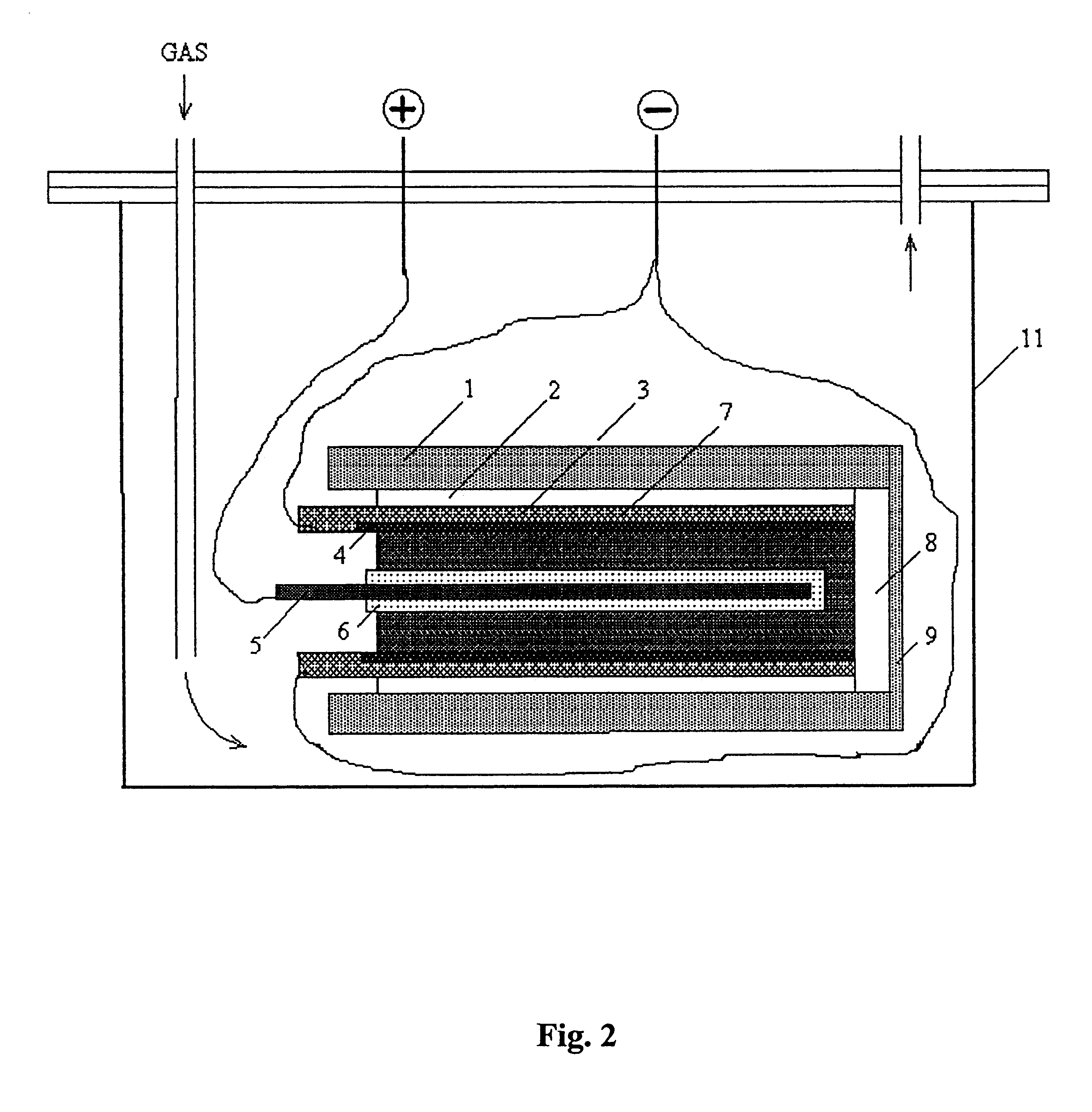Method of formation and charge of the negative polarizable carbon electrode in an electric double layer capacitor
a technology of carbon electrode and electric double layer capacitor, which is applied in the direction of capacitors, electrical equipment, protecting/adjusting hybrid/edl capacitors, etc., can solve the problems of capacitors that permit very low discharge and charge currents, low practical charge and discharge currents, and relatively low specific energy of capacitors
- Summary
- Abstract
- Description
- Claims
- Application Information
AI Technical Summary
Problems solved by technology
Method used
Image
Examples
example 1
The device in use was identical to that described in the second embodiment, set forth above. The formation process differed in some cycling parameters. Three charge-discharge cycles were performed instead of one with current density of 10 mA / cm.sup.2. The end-of-charge voltage was 0.6 V, the potential of the negative electrode being 1.1 V vs. RHE; the end-of-discharge potential was -0.9 V vs. RHE. Discharge at 10 mA / cm.sup.2 followed the formation. The resulting specific capacitance of the negative polarizable electrode and specific energy of the capacitor were 790 C / g and 29.5 Wh / kg, respectively.
example 2
The capacitor in this example employed two electrodes made of TSA activated carbon cloth 0.3 mm in thickness, the negative consisting of a single layer, and the positive of two layers. FIG. 6 shows five voltammograms of this system obtained at scan rate of 1 mV / sec in the potential range form 1.0 V to the corresponding final values: 0 V (curve 1); -0.2 V (curve 2); -0.5 V (curve 3); -0.8 V (curve 4); and -1.0 V (curve 5). The cathode branches stand for charge, while the anode ones stand for discharge of the negative electrode. The cathode branches of curves 4 and 5 exhibit maxima at 0.55 V, curve 5 testifying on sharp increase of the current, which most probably corresponds to hydrogen evolution. Extra area and thus extra discharge capacity was obtained under the anode branches of curves 2, 3, and 4. The anode part areas of curves 4 and 5 were basically equal, which renders the discharge capacities equal as well. One can see that enlargement of the potential window by 0.8 V in the n...
example 3
The hybrid capacitor used in this example was similar to that described in Example 1 in its polarizable electrodes, but a positive electrode of the NiOOH / Ni(OH).sub.2 type was employed instead of PbO.sub.2 / PbSO.sub.4 and 30% aqueous solution of KOH served as electrolyte. A multi-step formation charge was performed as follows: at the first step (down to 0.25 V vs. RHE) the current density was 7 mA / cm.sup.2 ; at the second step (down to -0.55 V vs. RHE) the current density was 15 mA / cm.sup.2 ; at the third step the current density was kept at 7 mA / cm.sup.2 for 5 hours. Three charge-discharge cycles followed then charge as described above and finally discharge at 7 mA / cm.sup.2 was performed. The resulting specific capacitance of the negative polarizable electrode was 750 C / g.
Those skilled in the art will recognize that the present invention is capable of many modifications and variations without departing from the scope thereof. Accordingly, the detailed description and examples set f...
PUM
| Property | Measurement | Unit |
|---|---|---|
| Time | aaaaa | aaaaa |
| Electric potential / voltage | aaaaa | aaaaa |
| Electric potential / voltage | aaaaa | aaaaa |
Abstract
Description
Claims
Application Information
 Login to View More
Login to View More - R&D
- Intellectual Property
- Life Sciences
- Materials
- Tech Scout
- Unparalleled Data Quality
- Higher Quality Content
- 60% Fewer Hallucinations
Browse by: Latest US Patents, China's latest patents, Technical Efficacy Thesaurus, Application Domain, Technology Topic, Popular Technical Reports.
© 2025 PatSnap. All rights reserved.Legal|Privacy policy|Modern Slavery Act Transparency Statement|Sitemap|About US| Contact US: help@patsnap.com



